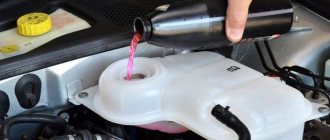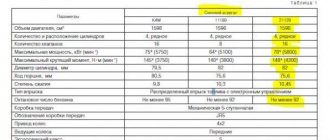Many car enthusiasts think about what kind of antifreeze is poured into the Lada Vesta from the factory only when it is time to change it or when it is necessary to urgently add coolant.
This is due to the fact that mixing antifreezes of different brands is not recommended, and those with different bases are generally prohibited. It is not recommended to fill the system with water (including distilled water), even in summer, since the coolant contains special additives that protect against corrosion. In addition, antifreeze contains lubricating components necessary for the water pump.
Engine oil
There are no “preferred” oils here anymore! All Vesta engines can be filled with any oil with API quality level SL or SM, as well as SN. The factory sets the viscosity parameters of the oil too wide. It is better to limit yourself to the following viscosity ranges depending on temperature:
| Minimum air temperature, °C | SAE viscosity grade | Maximum air temperature, °C |
| —40* | 0W-40 | 30 |
| —30 | 5W-30 | 25 |
| —30 | 5W-40 | 35 |
| —25 | 10W-30 | 25 |
| —25 | 10W-40 | 35 |
* Optimal oils for use in Russia are highlighted in bold.
If the temperature in your region is 40°C, then it makes sense to fill in 5W-50 type oils.
Requirements for antifreeze Lada Vesta
Antifreeze for Lada Vesta must have the following qualities:
— remove heat from the engine cylinders; - do not freeze at subzero temperatures; — do not form deposits inside the cooling system; — prevent the formation of rust; — do not cause damage to rubber parts; — do not foam during engine operation; - have the necessary lubricating properties.
As you may have noticed, the requirements for antifreeze on the Lada Vesta are not as few as it seems. And it’s not so easy to combine all these qualities in one liquid.
Lada Vesta: what kind of antifreeze is filled in from the factory?
From the factory, Sintec Antifreeze Lux G12 antifreeze is poured into the Lada Vesta car. It complies with TU 2422-047-51140047-2007. Antifreeze is red in color and is produced by Obninskorgsintez JSC in the city of Obninsk. Products of this brand are produced in volumes of 1, 3, 5, 10, 20 and 220 kg.
To order online you can use the following article numbers:
1kg - 613500 3kg - 990464 5kg - 614500 10kg - 756665 20l - 990470
And now a few words about the antifreeze itself. Sintec Antifreeze Lux G12 is the latest carboxylate antifreeze based on an aqueous solution of glycol and organic additives. Does not contain nitrites, nitrates, amines, phosphates, borates and silicates. Since 2011, this product was chosen as the main one for the first refueling of LADA cars at the AvtoVAZ plant. In addition, it is recommended to use Sintec Antifreeze Lux G12 during warranty and post-warranty service of Lada vehicles.
Antifreeze level Lada Vesta
The Lada Vesta antifreeze level must be monitored using marks on the expansion tank under the hood of the car. It is installed on the passenger side in the far corner of the engine compartment of the car and has the shape of a ball.
The tank indicates the minimum and maximum marks, as well as the type of liquid being filled. In our case it is G12. If there are no leaks in the cooling system and the engine has cooled down, the coolant level should be between the MIN and MAX marks. When the engine is warm, antifreeze expands and can reach its maximum level.
If the Lada Vesta antifreeze runs out and the level constantly drops, then you need to add coolant to the required amount and contact a specialized service. Factory antifreeze Lada Vesta has a special fluorescent additive that glows under ultraviolet light. Thanks to this, you can quickly determine the location of the coolant leak.
Is it possible to mix antifreeze?
Is it possible to mix antifreeze
different manufacturers? The operating manual for the LADA vehicle states: “The use of mixtures of coolants of different brands is not allowed.”
Can you mix antifreeze
different colors, but from the same manufacturer?
There is no definite answer, because... Some manufacturers color the coolant “to taste,” while others add color based on the chemical composition or additives. According to statistics, about 85% of motorists do not mix antifreeze of different colors. At the same time, 64% believe that if you mix antifreeze
of different colors, nothing bad will happen. You can view the survey and take part in it here.
The book on operation, maintenance and repair of the LADA Vesta car states:
Coolant replacement
Antifreeze on Vesta needs to be replaced periodically, since it loses its properties over time, and insoluble particles may appear in it from the internal surfaces. Waste fluid increases wear on the pump's sliding bearing, which often leads to its failure. This is especially true for the engine jacket, inside of which it is technically difficult to remove scale.
Photo source: https://www.zr.ru/content/articles/852383-lada-vesta-instrukciya-po-zamene-oxlazhdayushhej-zhidkosti/2581/
When replacing coolant, it is important to use the recommended brand, observe replacement periods, and ensure compliance with technical operating conditions. Prices should not be taken into account, since even the most expensive composition will be cheaper than even minor CO repairs.
When is it time to change antifreeze?
You need to change antifreeze in a Lada Vesta or Cross after a mileage of 90 thousand km or 60 months of operation since the last replacement. The condition that occurred first is selected.
Fill with factory-recommended antifreeze with special additives designed to increase corrosion resistance.
Which antifreeze to choose for Lada Vesta
What antifreeze should I put in Vesta? AvtoVAZ allows the use of liquids only of class G12. In addition to antifreeze produced by Sintec, a number of analogues can be used:
- Cool Steam Premium or Standard;
- Felix Carbox;
- G-Energy Antefreexe;
- TC-Felix.
Photo source: https://www.zr.ru/content/articles/852383-lada-vesta-instrukciya-po-zamene-oxlazhdayushhej-zhidkosti/2581/
Original fluids from the Lada car manufacturer are suitable; their properties and color (yellow-pink) are the same as those produced by Sintec. Other compounds that have a quality certificate from AvtoVAZ are also permitted.
Is it possible to mix different coolants?
The development of antifreeze by manufacturers takes into account the technical characteristics, functional features of the lines used, pumps, radiators and other components. Their chemical compositions differ, so mixing may result in the formation of compounds whose effect on the cooling circuit is unknown.
It is difficult to predict the consequences of mixing several types of compounds in advance, even if the following conditions are met:
- matching liquid color;
- one manufacturer;
- one brand;
- identical characteristics of the compositions.
Compositions may differ between shipments as manufacturers strive to improve the properties of the coolant. In case of critical situations, you can add a similar composition, but after reaching the service station, you should completely replace the antifreeze.
Photo source: https://www.zr.ru/content/articles/852383-lada-vesta-instrukciya-po-zamene-oxlazhdayushhej-zhidkosti/2581/
Mixing is likely to cause serious damage to the CO, requiring costly repairs. Also, these actions will void the warranty on the car. Therefore, mixing antifreeze is strictly prohibited.
How to drain coolant from Vesta
Drain antifreeze or any other antifreeze in the following order:
- Drive the car onto the overpass.
- Wait until the engine cools down.
- Remove the protective plate from the power unit.
- Unscrew the 3 bolts securing the starter to the clutch housing and remove it. Access the drain screw.
- Place a 10 liter container under the radiator.
- Use a clamp to release the hose clamp (for a compression type) or unscrew a screwdriver (for a threaded type) on the radiator outlet to drain so that the liquid flows into a container.
- Unscrew the plug located on the cylinder block.
- Unscrew the expansion tank cap and increase the drain speed.
- After completing the procedure, install the parts in place.
After draining, fill in new antifreeze and make sure there are no leaks. The procedure is shown in more detail in the video.
How much antifreeze to pour into Vesta
The amount of coolant poured into the Lada Vesta at the factory is 7.84 liters. Therefore, for a complete replacement you need at least 8 liters. You will have to buy a canister of antifreeze, the volume of which is 10 liters, so that the remaining 2 liters can be used for topping up if the level drops.
Fill in antifreeze only when the engine is cool and not running, provided the system is sealed. The level should be maintained in the middle between two marks: minimum and maximum. When heated, the liquid expands and can therefore exceed the maximum level.
Replacing Lada Vesta antifreeze with your own hands
Antifreeze must be replaced after 90,000 thousand kilometers or after 3 years, whichever comes first. This interval is set by the factory. However, based on real conditions, this Lada Vesta coolant replacement interval can be safely reduced by 1.5 - 2 times, since even after this time the coolant begins to lose its properties. In order not to wait for the complete “death” of the antifreeze, it is better to replace it a little earlier.
We will talk about replacing antifreeze in the next article in order to exclude the theory from it, and immediately start with the practical part. And now it’s time to finish our article and say goodbye to you. Thank you for your attention and see you again. Don't forget to leave comments on the site!
Where to fill
The plug has been tightened, now we fill it into the system until the expansion tank is full. I recommend pouring in a thin stream to avoid air lock. Don't forget about the starter, put it in place. We filled the system with antifreeze, put the terminal in place, and started the car. While the power unit is operating, we begin to compress all the hoses several times. This approach will ensure good filling of the system and air outlet. We monitor the fluid level, as it may gradually drop. It all depends on the uniform filling of the system when filling liquid and the release of air. Fill to the set level. Do not forget to tighten the plug. Initially, with a cold engine, the lower pipe will be cold for the first minutes after starting, but as the engine warms up, it will begin to warm up and become hot - this means that the system is fully operational, the liquid flows in a large circle - the thermostat has opened. We are waiting for the fan to turn on. Then we checked all the pipes again to make sure they were hot. It’s better to make sure once again that the entire system is full and there are no plugs. We turn off the engine.
When the engine has cooled down, check the fluid level once and, if necessary, add to the required level. That's all, the cooling system has been successfully serviced.
Where can I buy?
You can buy antifreeze for Lada Vesta in many online stores. By the way, if you purchase it under the Lada label, it will be even cheaper than under the Sintec brand. However, the difference in cost is insignificant in any case, and therefore it is not worth focusing on it.
The table shows the most popular sites, as well as the volume of capacity.
| Online store | vendor code | Capacity(L) | Price, rub.) |
| https://lada-vesta-shop.ru/shop/sistema-ohlazhdenija/antifriz-dlja-lada-vesta-krasnyi-g12.html | VS-ALVG12 | 5 | 620 |
| https://lada-vesta-shop.ru/shop/sistema-ohlazhdenija/antifriz-dlja-lada-vesta-krasnyi-g12.html | VS-ALVG12 | 1 | 145 |
| https://ladatorg.ru/avtomaterialy/antifrizy/antifriz-sintec-lux-g12/ | 379 | 1 | 120 |
| https://www.ulmart.ru/goods/3831343 | 3831343 | 10 | 1030 |
| https://www.auchan.ru/pokupki/antifriz-sintec-lux-g12-1-kg.html | 52796 | 1 | 127 |
| https://dvizhcom.ru/catalogs/27771/ | 27771 | 5 | 603 |
How the Vesta engine is cooled
Each owner must monitor the condition of the cooling system (CO) and carry out timely maintenance to prevent overheating of the power unit. Lada Vesta uses a closed liquid system with forced circulation of working fluid. Principle of operation:
- When the engine is running, the cooling jacket heats up. If the temperature rises to a level in the range from +85°C to +89°C, the thermostat opens and fluid circulates in the system in a small circle past the engine radiator.
- The heated liquid circulates through the tubes, cools to a certain temperature, and then flows through the system again into the engine jacket.
- When the temperature reaches +102°C, the thermostat fully opens the valve and the OS begins to work with maximum efficiency.
- The heated liquid from the cooling jacket is directed to the interior heating radiator.
- In case of critical overheating, excess fluid enters the expansion tank, and an emergency sensor is activated, signaling the driver about overheating.
Photo source: https://www.zr.ru/content/articles/852383-lada-vesta-instrukciya-po-zamene-oxlazhdayushhej-zhidkosti/2581/
On power units from AvtoVAZ with a volume of 1.6 or 1.8 liters, the pump is brought into operation via a timing belt drive.
In the cold season, an electric heater is used to facilitate engine starting. It also serves for partial heating of antifreeze and stable operation of CO.











